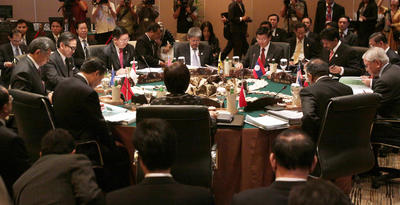The global financial crisis and the emergence of the Group of 20 (G20) has changed this dramatically and gives the G20’s Asian members the opportunity, at least, to assume a new role and their proper responsibilities in managing the world economic order. The ten-nation Association of Southeast Asian Nations (ASEAN) is still the fulcrum of Asian cooperation arrangements, including Asia Pacific Economic Cooperation (APEC), the ASEAN Regional Forum (ARF), ASEAN+3 (the 3 being Japan, China and Korea) and the newly expanded East Asian Summit (EAS). But with the rise of the bigger powers in Asia and the emergence of the G20 this seems likely to change. There is a new and immense fluidity in the shape of regional architecture despite the recent initiative to include the US and Russia in the EAS dialogues. The rise of Asia suggests that the time is right for Asian leadership. But what are the prospects for a coherent approach from Asia to the crisis in the international economy today? And can Asia step up to exercise the responsibilities the rest of the world now increasingly expects it to do?
In this week’s lead, Wendy Dobson sees the emergence of Asian leadership in global affairs as a slow and gradual process. ASEAN, which has been at the core of Asian institutional arrangements, hasn’t the strength to do what is needed now. So ‘will the region continue to cede the leadership of the world trading system to the United States and Europe, as it has through much of the post-war period? Or will it use its increasing economic weight to shape the world order by, say, helping to conclude the Doha Round, forging a new approach in the WTO post-Doha or building a Pacific-wide free trade area?’
It makes little sense for Asia to rely too heavily on Europe and the United States for leadership at the global level given their internal troubles that will distract them and cause defensive policies for the foreseeable future.
The scale of Asia’s impact on the global economy means that the need to mobilise regional efforts to deliver on Asia’s global responsibilities — in the financial and macro-economy, in trade policy (which the collapse of Doha makes a more urgent priority) and on climate change — is a task that is more and more pressing and one that needs to be managed more actively through regional institutions.
Getting this right in practice may be more complicated than it appears in principle. It will require decisions about which regional arrangements provide the most effective link between regional and global cooperation. Many of the initiatives will sensibly require strengthening East Asian arrangements (at least within ASEAN+6 which includes the +3 and India, Australia and New Zealand), perhaps via enhanced financial cooperation through finance ministry and finance agency involvement (the Asian Financial Stability Dialogue AFSD, for example). Others will benefit from participation of a broader Asia Pacific group.
Getting the connection between regional and global arrangements right will require careful attention to scheduling regional meetings and initiatives so that they can both make useful input into, and be reinforced by, the efforts in global cooperation. Success will depend heavily upon the logistical detail. There needs to be much careful thought given to this question. The legitimacy of the G20 will depend on how the interests and views of non-G20 members are brought to the G20 process. Structuring the timing of Asia’s regional meetings around the G20 to give the regional non-G20 members input and ownership of initiatives is an important start. The implication is that, while ASEAN provides a critical modus operandi for regional initiatives, the agenda and schedule for regional arrangements, if regional institutions are to remain relevant, needs also and essentially to be driven from elsewhere.
Dobson reckons that in Asia it is likely that efforts could be made to use scarce leadership resources better in the continuing variable geometry in which the broadest membership of East Asian arrangements meets to discuss strategic issues. With time and experience it might also engage in setting and monitoring goals and targets if such goals and targets were adopted, similar to the G20’s emerging role at the global level. Crises will require managers, though, and are likely to require a steering committee of the largest economies. That suggests a group of the large players, perhaps the six Asia members of the G20 (including Australia) working with North America might emerge as the leading players. How ASEAN remains relevant is another issue.
Meanwhile Asia has a great deal at stake in fronting up with recovery and growth strategies that support G20 efforts to deal with the collapse in global economic confidence.
Peter Drsydale

